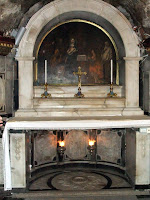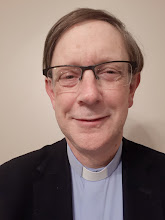Today was Sunday and I went to the 8am service in St George's cathedral. The service was significantly livened up by the arrival of around 100 Kenyans with their Bishop. Although this is normally a said service, the Kenyan worshippers led us in offertory songs and a final hymn. The colour of their clothes and the vitality of their worship brought real richness to the occasion.
Following lunch we went to Ein Kerem, traditionally remembered as the birthplace of John the Baptist. Ein Kerem is a village 7km southwest of Jerusalem, which was formerly Palestinian, but has now become a popular location for Jewish artists and sculptors. It boasts some chic galleries and restaurants. There are two main churches there, the Church of the Visitation and the Church of St John the Baptist, and two religious communities too - a Russian monastery and a Roman Catholic convent.
The Church of the Visitation is a Franciscan foundation with a lower and an upper church.
Antonio Barluzzi, an architect whose work we had seen before (e.g. at Bethany), was responsible for the design of the upper church here.
But I found that the smaller church down below - a redevelopment of an earlier Crusader building, was more affecting.
There were some lovely frescoes in both churches. I like this one of Mary's visitation to Elizabeth.
An ingenious solution to the two potentially competing sites is the view that Mary visited Elizabeth at her summer house, and that her normal residence was on the other side of the valley!
The Church of St John the Baptist is also a Franciscan church. There was a Byzantine Church in this place, which was rebuilt by the Crusaders. The Crusader Church fell into complete disrepair and it was restored in 1674 with gifts from the Spanish monarchy. The Church was notable for the wonderful 17th century Spanish art on the walls.
The most revered site in the church is the grotto. It is believed to be part of the home in which John the Baptist was born to Zechariah and Elizabeth, and perhaps even the site of his birth.
As we returned to the bus we caught sight of the beautiful Russian monastery on the hill. It looked very impressive.
In the evening we had a visit of a different kind. This time an Israeli man called Yakir Englander visited the College to speak to us about the land of Israel from a Jewish perspective. (I didn't take a photo at the lecture so got this file photo from the internet.)
He was a very impressive man. Many of us asked in one way or another about the treatment of the Palestinians, and he didn't get defensive in his answers. He clearly indicated his concern for the situation, while also being quite clear that the building of the wall had radically reduced the number of deaths in Israel due to terrorist bombs.
He had been brought up in a strict Hasidic household but in his late teens or early twenties had come to realise that he needed to get out of that setting. Hasidic Jews are exempt from military service, so his decision to leave that life meant that he needed to serve in the army. In Jewish belief, the preservation of the dead person's body in death is very important, and so they go to some lengths to make sure that corpses are as whole as possible. During his time in the army Yakir volunteered to work collecting body parts of those who had died in an explosion or crash. This gave him a particular and quite understandable perspective on terrorist bombings.
Because of his concern for young people in Israel, and for the gulf between Jews and Palestinians, he established a programme called 'Kids for Peace', which gathers young people from those two groups and gives them time together to tell their stories to one another. It is obviously a really excellent programme that leads to much greater understanding.
He told a very moving story about a Palestinian woman who worked for Kids for Peace telling him that she had to resign. He asked why and she told him that her son had been arrested without charge by the Israeli forces and that she was too angry about it to go on helping with the programme. He persuaded her to keep on with it and tried to give her whatever help he could through the difficult time - around two years - during which the woman's son was in custody without charge. Eventually the judge refused to renew the order and the young man was released. There was a party for the young man in his family home on the West Bank, and as you can imagine many of the people who gathered were quite hostile towards the Israelis. Yakir was invited too, so he asked the family whether he would be safe coming to the party. They assured him that they would guarantee his safety. As he approached the house he had the scary sensation of people looking at him, knowing that he was an Israeli. When he arrived at the party, the young man who had been in prison for two years embraced him and said to him, "thankyou for all the support you have given to my mother".
As you can see from the above, I was highly impressed by Yakir. He came across as a person of great ability and very significant commitment to compassion and justice for all. He seemed the sort of person who will make a real and positive difference to the world.











2 comments:
Dear Peter,
thank you for sharing your experiences and photographs from the Holy Land! For an Holy Land association here in France I am issuing a calendar "Holy Land 2011". It would be joy indeed if I could use your photograph of the Visitation Church for illustration of the feast of visitation in may, naturally giving you full photo credits. Could you please contact me at carina.scholz@sciences-po.org? Thank you very much in advance! Best regards, Carina.
Thanks for share this Prophet John
Post a Comment